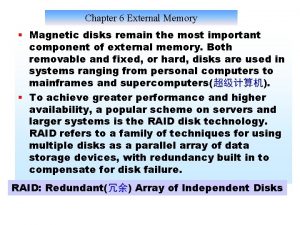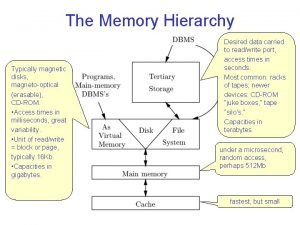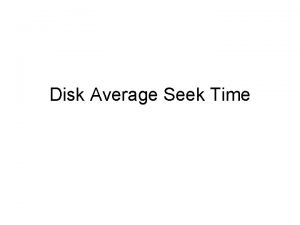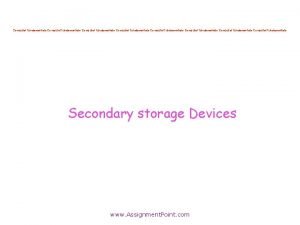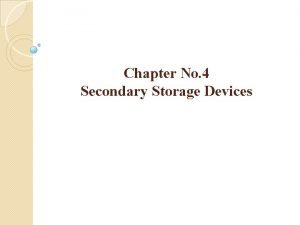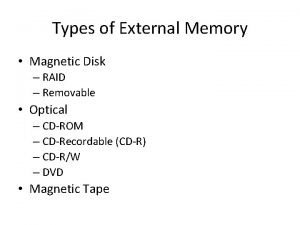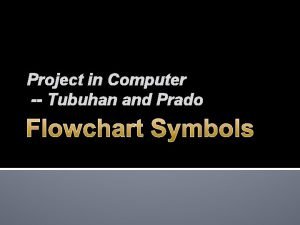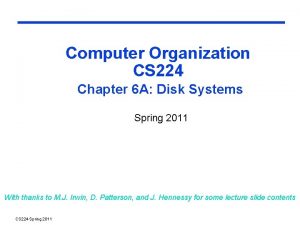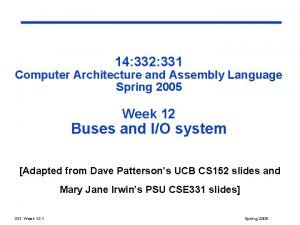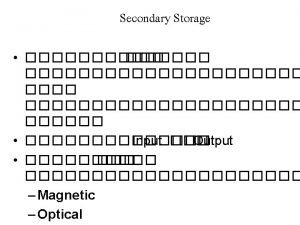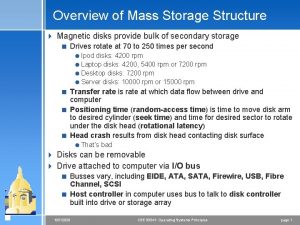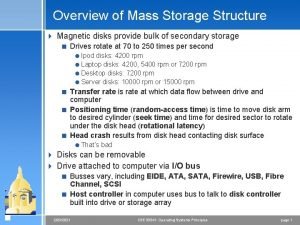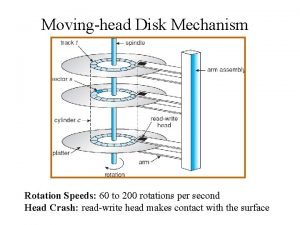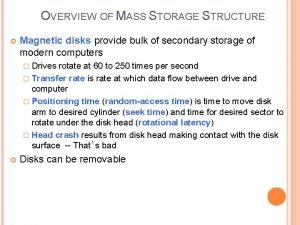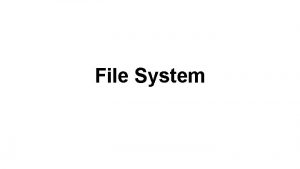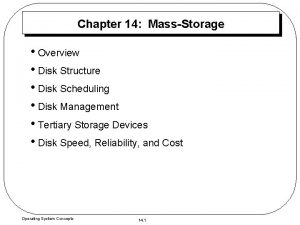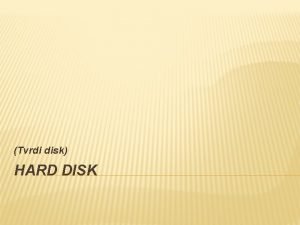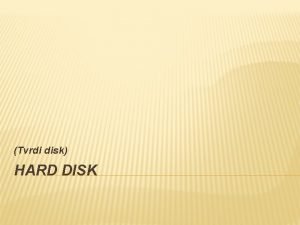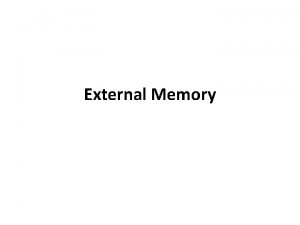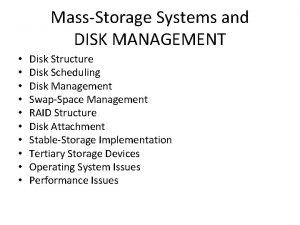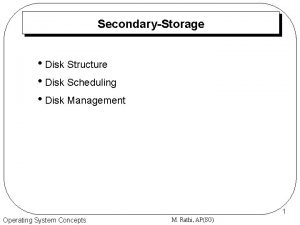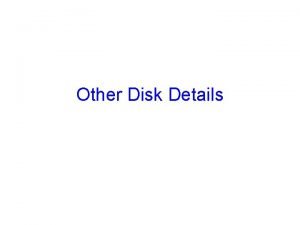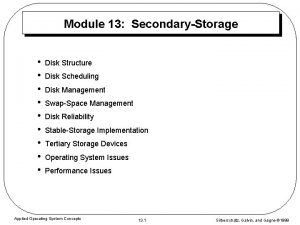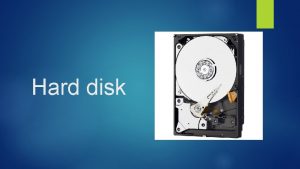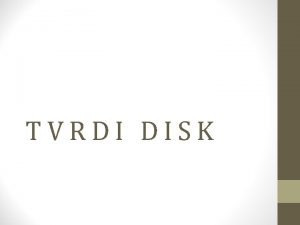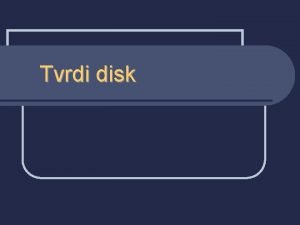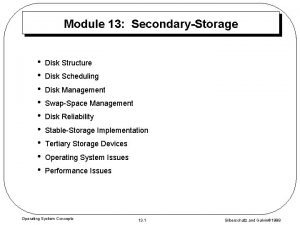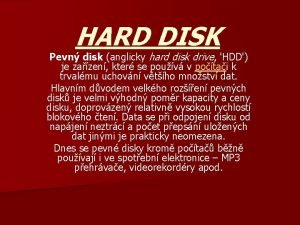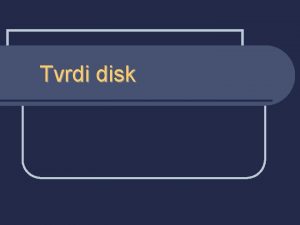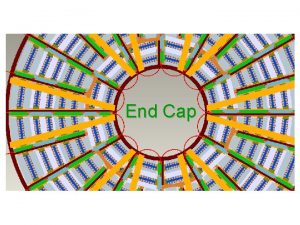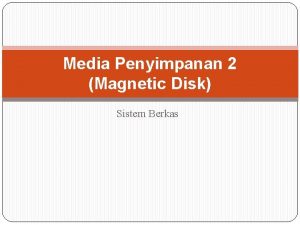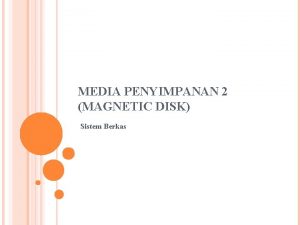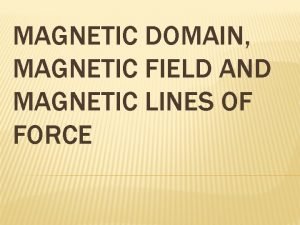Disk and IO Management Movinghead Disk Mechanism Magnetic





















- Slides: 21

Disk and I/O Management

Moving-head Disk Mechanism

Magnetic Disk Performance • Average access time = average seek time + average latency+ transfer time • For example, to transfer a k bytes block on a 3600 RPM disk with a 10 ms average seek time with a. 1 ms controller overhead • Track size=32 k. B • block size k Rotation time=60/3600 sec=16. 67 ms Average rotational latency=(0+r)/2=r/2 Avg. access time=seek time+ rotational delay +transfer time – 10 ms + 8. 3 ms + (k / 32 KB)× 16. 67 sec +0. 1 ms

Disk Scheduling • The operating system is responsible for using hardware efficiently – for the disk drives, this means having a fast access time • Minimize seek time • Seek time seek distance (depends on track numbers)

Disk Scheduling • There are many sources of disk I/O request – System processes – Users processes • OS maintains queue of requests, per disk or device • Idle disk can immediately work on I/O request – busy disk means work must queue • Note that drive controllers have small buffers and can manage a queue of I/O requests (of varying “depth”) • Several algorithms exist to schedule the servicing of disk I/O requests • We illustrate scheduling algorithms with a request queue (0 -199) 98, 183, 37, 122, 14, 124, 65, 67 Head pointer 53 (track numbers)

FCFS Illustration shows total head movement of 640 cylinders

SSTF • Shortest Seek Time First selects the request with the minimum seek time from the current head position – Close to the current disk head

SSTF Illustration shows total head movement of 236 cylinders

SSTF • Shortest Seek Time First selects the request with the minimum seek time from the current head position – Close to the current disk head • Greedy – Not necessarily optimal • SSTF scheduling may cause starvation of some requests

SCAN • The disk arm starts at one end of the disk, and moves toward the other end, servicing requests until it gets to the other end of the disk, where the head movement is reversed and servicing continues. • SCAN algorithm Sometimes called the elevator algorithm • But note that if requests are uniformly dense, largest density at other end of disk and those wait the longest

SCAN Illustration shows total head movement of 208 cylinders

C-SCAN • Provides a more uniform wait time than SCAN • The head moves from one end of the disk to the other, servicing requests as it goes – When it reaches the other end, however, it immediately returns to the beginning of the disk, without servicing any requests on the return trip • Treats the cylinders as a circular list that wraps around from the last cylinder to the first one

C-SCAN (Cont. )

LOOK • LOOK a version of SCAN, C-LOOK a version of C-SCAN • Arm only goes as far as the last request in each direction, then reverses direction immediately, without first going all the way to the end of the disk

C-LOOK (Cont. )

Selecting a Disk-Scheduling Algorithm • Requests for disk service can be influenced by the file-allocation method – Contiguous, indexed etc – Location of Directory , i-node • The disk-scheduling algorithm should be written as a separate module of the operating system, allowing it to be replaced with a different algorithm if necessary – Either SSTF or LOOK is a reasonable choice for the default algorithm • But implemented inside disk controller – Physical block info is inside controller • How does disk-based queuing effect OS queue ordering? – – OS has other constraints Demand paging over normal I/O Controller is unaware of that File organization module ensures the order

Disk Layout

Disk Management • Low-level formatting, or physical formatting — Dividing a disk into sectors that the disk controller can read and write – Each sector can hold header information, plus data, plus error correction code (ECC) – Usually 512 bytes of data but can be selectable – Logical to physical address map • To use a disk to hold files, the operating system still needs to record its own data structures on the disk – Partition the disk into one or more groups of cylinders, each treated as a logical disk – Logical formatting or “making a file system” – Create the data structures (FAT, directory, inode, free space)

Application I/O Interface • OS structure enables the I/O devices to be treated in a standard/uniform way – Application can open a file on a disk without knowing the disk details – New devices can be added without disrupting the OS

Application I/O Interface • Abstract away detailed differences in I/O devices identifying few general/standard syscall (read(), write()) • Interface • I/O system calls encapsulate device behaviors in generic classes • Kernel program interacts with I/O system using standard system call • Device differences are encapsulated within device drivers (custom tailored for that device) => provides a generic interface to interact • Device-driver layer hides differences among I/O controllers from kernel • Want to add new device? – New devices talking already-implemented controller need no extra work • Otherwise write a driver for that device (specific to particular OS)

Thank you
 Magnetic disk read and write mechanism
Magnetic disk read and write mechanism Magnetic retentivity
Magnetic retentivity Unit of magnetic flux density in weber
Unit of magnetic flux density in weber Magnetic moment and magnetic field relation
Magnetic moment and magnetic field relation F=i(lxb)
F=i(lxb) Magnetic disk in memory hierarchy
Magnetic disk in memory hierarchy Seek time hard disk
Seek time hard disk Assignment on storage devices
Assignment on storage devices Magnetic storage
Magnetic storage Fixed-head magnetic disk storage
Fixed-head magnetic disk storage Delay flowchart symbol
Delay flowchart symbol Magnetic disk
Magnetic disk Magnetic disk
Magnetic disk Floppy disk secondary storage
Floppy disk secondary storage Structure of magnetic disk
Structure of magnetic disk Flowchart summing junction
Flowchart summing junction Structure of magnetic disk
Structure of magnetic disk Moving head disk mechanism
Moving head disk mechanism The head of moving head disk
The head of moving head disk Moving head disk mechanism
Moving head disk mechanism Moving head disk mechanism
Moving head disk mechanism Disk structure in operating system
Disk structure in operating system
